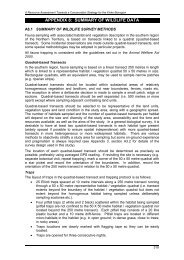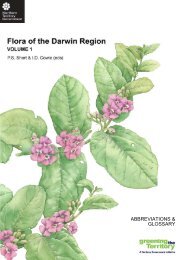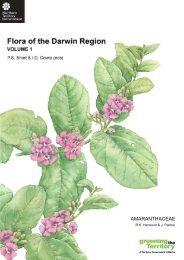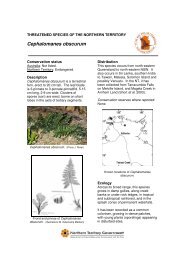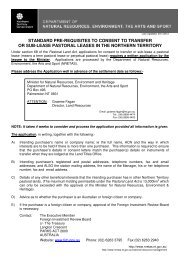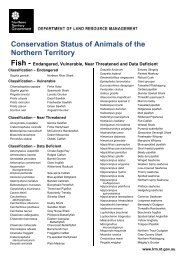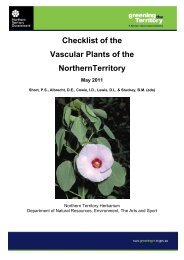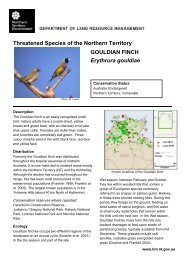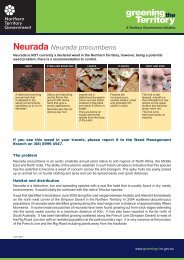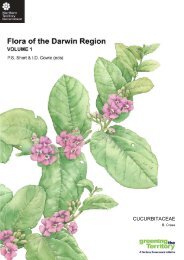Guidelines and Field Methodology for Vegetation Survey and Mapping
Guidelines and Field Methodology for Vegetation Survey and Mapping
Guidelines and Field Methodology for Vegetation Survey and Mapping
You also want an ePaper? Increase the reach of your titles
YUMPU automatically turns print PDFs into web optimized ePapers that Google loves.
SECTION A: GUIDELINES<br />
5.0 NVIS CLASSIFICATION FRAMEWORK AND<br />
NOMENCLATURE<br />
Classification plays an important role in vegetation survey <strong>and</strong> mapping. The primary goal of a<br />
classification system is to define patterns <strong>and</strong> simplify complex vegetation data.<br />
Traditionally, NRETA L<strong>and</strong> <strong>and</strong> <strong>Vegetation</strong> have used a modified Carnahan/Specht (1981)<br />
classification system <strong>for</strong> pure vegetation mapping where vegetation is characterised by the tallest<br />
stratum. The tallest stratum is also considered to be the dominant stratum, provided canopy cover<br />
values are greater than 5%. For l<strong>and</strong> unit mapping in the NT the Walker <strong>and</strong> Hopkins (1990)<br />
classification system also characterises vegetation by the tallest stratum. The two classification<br />
systems rely on slightly different criteria <strong>and</strong> once applied to a map are not directly comparable.<br />
Similarly at the national level, State <strong>and</strong> Territory agencies involved in vegetation survey <strong>and</strong><br />
mapping have used different classification systems. Recognising this, a national st<strong>and</strong>ard, the<br />
NVIS framework, <strong>for</strong> classifying vegetation map units <strong>and</strong> descriptions was developed.<br />
The principle objective of vegetation survey is to identify vegetation communities with similar<br />
characteristics (i.e. floristic, structural <strong>for</strong>mation & environmental attributes) by:<br />
1. Describing vegetation communities at a recognised classification level (i.e. NVIS<br />
In<strong>for</strong>mation Hierarchy Level V – Association & Level VI - Sub-association; refer to<br />
Chapter 5.1) <strong>for</strong> survey reports;<br />
2. Attributing preliminary unique mapping areas at a recognised classification level<br />
(generally Level V – Association; refer to Chapter 5.1) to establish regional patterns of<br />
vegetation community distribution, <strong>and</strong><br />
3. Providing an underst<strong>and</strong>ing of ecosystem relationships by identifying links between<br />
individual species distribution <strong>and</strong> co-occurrence with a set of environmental factors<br />
(i.e. physical, biological & disturbance attributes).<br />
To achieve the above, field data is analysed <strong>and</strong> classified into floristic <strong>and</strong> structural groupings<br />
using a recognised classification system.<br />
5.1 NVIS Structural Classification<br />
The NVIS framework is based on an in<strong>for</strong>mation hierarchy of six levels (Table 4) <strong>and</strong> a structural<br />
classification system. The purpose of the hierarchy is to define <strong>and</strong> st<strong>and</strong>ardise structural <strong>and</strong><br />
floristic map unit in<strong>for</strong>mation, provide a framework <strong>for</strong> quality control <strong>and</strong> assurance of vegetation<br />
description in<strong>for</strong>mation <strong>and</strong> generate outputs at various levels (eg. map products).<br />
The NVIS In<strong>for</strong>mation Hierarchy (ESCAVI, 2003) has been adopted by NRETA L<strong>and</strong> <strong>and</strong><br />
<strong>Vegetation</strong> to map <strong>and</strong> describe vegetation communities in the NT. A database has been built to<br />
accommodate this (refer to Chapter 7.3). A large amount of historic NT vegetation data has been<br />
translated into the NVIS classification system. Future vegetation mapping should adhere to the<br />
NVIS classification system.<br />
Northern Territory <strong>Guidelines</strong> <strong>and</strong> <strong>Field</strong> <strong>Methodology</strong><br />
<strong>for</strong> <strong>Vegetation</strong> <strong>Survey</strong> <strong>and</strong> <strong>Mapping</strong><br />
10



